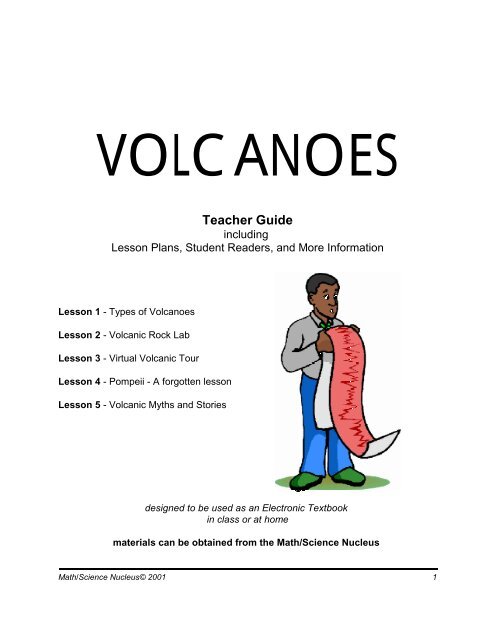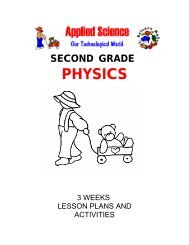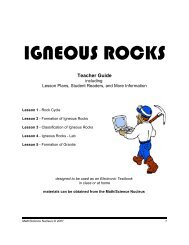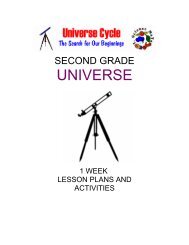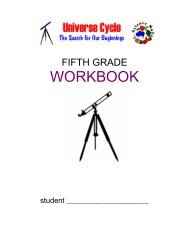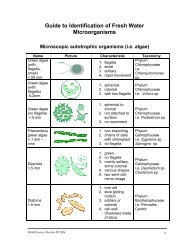Volcanoes - Math/Science Nucleus
Volcanoes - Math/Science Nucleus
Volcanoes - Math/Science Nucleus
Create successful ePaper yourself
Turn your PDF publications into a flip-book with our unique Google optimized e-Paper software.
VOLCANOES<br />
Teacher Guide<br />
including<br />
Lesson Plans, Student Readers, and More Information<br />
Lesson 1 - Types of <strong>Volcanoes</strong><br />
Lesson 2 - Volcanic Rock Lab<br />
Lesson 3 - Virtual Volcanic Tour<br />
Lesson 4 - Pompeii - A forgotten lesson<br />
Lesson 5 - Volcanic Myths and Stories<br />
designed to be used as an Electronic Textbook<br />
in class or at home<br />
materials can be obtained from the <strong>Math</strong>/<strong>Science</strong> <strong>Nucleus</strong><br />
<strong>Math</strong>/<strong>Science</strong> <strong>Nucleus</strong>© 2001 1
MATERIALS:<br />
EARTH SCIENCES - VOLCANOES<br />
Lesson 1 - TYPES OF VOLCANOES<br />
reader<br />
world map placemat<br />
inflatable world globe (optional)<br />
Objective: Students compare the<br />
different type of volcanoes.<br />
Teacher note<br />
<strong>Volcanoes</strong> provide the structural evidence needed to look at patterns<br />
throughout the Earth’s record. The volcanic rocks leave clues to compare the<br />
present distribution of volcanoes with the past. Unfortunately earthquakes leave<br />
little evidence throughout geologic time.<br />
Students will learn the different ways to classify volcanoes. Dormant, active,<br />
and sleeping volcanoes tell about the possibility of eruptions in an area. The shape<br />
and types of rocks can help classify volcanoes into shield, composite, and cinder.<br />
Students also look at where volcanoes occur today and how they help to define<br />
plate boundaries. Make sure students can locate each of these areas on a world<br />
In this 1943 drawing, the Little Prince is trying<br />
to prevent a volcano from erupting. Unfortunately his<br />
intentions were noble, but no human can prevent a<br />
volcanic explosion. The forces behind an erupting<br />
volcano are greater than any type of bomb humans<br />
have created.<br />
<strong>Volcanoes</strong> are found throughout the world, but<br />
in defined zones. Some volcanoes are active, some<br />
dormant, and some extinct. An active volcano<br />
includes Mt. Etna, located in southern Italy. Activity<br />
includes lava movements and little “hiccups” of gas<br />
spirting from its top vent. An example of a dormant<br />
volcano is Mt. Lassen, in northern California. Its last<br />
eruption was in 1915, with only quiet murmuring<br />
since then. An extinct volcano may not even look like<br />
a volcano, but the rocks it left behind are<br />
unmistakable. An example would be some of the small islands in the Pacific. Even the<br />
northwestern islands of Hawaii are extinct!<br />
<strong>Math</strong>/<strong>Science</strong> <strong>Nucleus</strong>© 2001 2
A volcano is molten magma from the upper mantle or crust<br />
that has reached the surface. The liquid rock is referred to as<br />
lava when it refers to volcanoes. Lava will cool down and<br />
become a fine grained igneous rock (volcanic) and magma when<br />
cooled with be a large grained igneous rock (plutonic).<br />
<strong>Volcanoes</strong> have different<br />
styles of eruption. They can be<br />
violent or they can be quiet.<br />
Violent eruptions are usually<br />
charged with “bottled” up<br />
gases. Just like a can of<br />
carbonated soda that you<br />
shake and then quickly open.<br />
Ash and volcanic bombs rain down after a violent<br />
eruption.<br />
<strong>Volcanoes</strong> are also classified by the general<br />
shape and the type of rocks. There are many different<br />
type of classifications that vulcanologists use depending<br />
on the depth of your research. Basically there are three<br />
types of volcanoes based on composition including<br />
composite, shield, and cinder.<br />
The main island of Hawaii is very active. The volcanoes<br />
of Hawaii extrude very thick lava, which creates a “shield-like” shape.<br />
The Hawaiian volcanoes are classic examples of shield volcanoes.<br />
The eruption is not always in one large vent, but in can occur in<br />
fissures. The lava that is emitted from Hawaii begins to cool as it<br />
reaches the surface of the Earth. The cooling lava causes many<br />
wonderful appearances.<br />
It can create spectacular rivers of lava that race down the sides<br />
of the volcano. Lava<br />
may continue to flow as<br />
the crust thickens,<br />
causing internal tubes<br />
Pahoehoe lava where the lava once<br />
flowed.<br />
Flows of lava when cooled form<br />
pahoehoe lava, which is a Hawaiian word for<br />
“ropey,” can be seen throughout the islands.<br />
Lava when it reaches the ocean, creates a<br />
glassy coating over it and forms “pillow lavas.”<br />
Hawaiian volcano as the lava flows into the<br />
ocean.<br />
<strong>Math</strong>/<strong>Science</strong> <strong>Nucleus</strong>© 2001 3
Mt St Helens, in the state of Washington was<br />
dormant until it woke up on May 18, 1980. This volcano<br />
blew its top and the once calm and beautiful mountain<br />
became a catastrophe. The rocks that caps the caldera,<br />
were turned into ash by the force of the volcanic<br />
explosion. Ash blew into the atmosphere that was carried<br />
for thousands of miles. The ash mixed with the melting<br />
snow and caused walls of muds to flows down the<br />
mountainside. Burying trees, houses, and animals in a<br />
wall of fast moving<br />
wall of mud.<br />
Before the eruption<br />
Lava has<br />
slowly built the mountain again, but the lava was much<br />
thicker than the Hawaiian volcanoes. Layers of ash,<br />
lava, mud, and other volcanic rocks produce what is<br />
called a composite volcano. Sixty-four people lost<br />
their lives in this eruption, including a scientist who<br />
studied the volcano (vulcanologist). He was incinerated<br />
by a pulse of hot, dry gas.<br />
During the eruption, May, 1980.<br />
Lassen Volcano was declared a national park<br />
in 1916 after it began erupting in 1914. Both<br />
composite and cinder cone volcanoes were found<br />
during its eruptive stage. Activity stopped in 1921,<br />
and is now considered a dormant volcano.<br />
There are still signs of a hot magma chamber<br />
below. In an area called Bumpus’ Hell, you can find<br />
bubbling mud and sulfur smelling steam. Even<br />
when the weather is cold, this area is always warm.<br />
Mr. Bumpus, was an early pioneer who decided to<br />
have a warm bath. To his horror, when he jumped in<br />
the water it was so hot, he lost his legs! He survived<br />
his own personal hell.<br />
<strong>Math</strong>/<strong>Science</strong> <strong>Nucleus</strong>© 2001 4
Paricutin in 1946 showing the pyroclastic materials<br />
being ejected from the vent. (USGS)<br />
The eruption began in 1943 and ended<br />
in 1952. Pyroclastic fragments of spheroidal<br />
bombs, lapilli, glassy cinders, and ash were<br />
the main components of the cinder cone.<br />
Chaia di Luna with layers of ash making up the cliff.<br />
Paricutin, Mexico is a volcano that<br />
grew from a farmer’s cornfield. Farmers had<br />
been experiencing earthquakes prior to the<br />
eruption. The eruption was a spectacular<br />
event that created a initial cinder cone that<br />
grow to 36 m (1,100 feet) to a volcano with<br />
extensive lava flows.<br />
March, 1944 the cinder cone was a prominent part<br />
of what was once a cornfield.<br />
Ponza is an island in the Tyrrehenian Sea, in Italy. It is located west of Naples. The island<br />
is now part of the Italian Park system, but was once part of a violent undersea volcano in<br />
the Pliocene and early Pleistocene. The rocks tell the story of a storm of ash and other<br />
pyroclastic materials being spurred from fractures on the sea bottom. This volcanic<br />
eruption has stopped, and is considered extinct. Howerver, not far from Ponza is Mount<br />
Vesuvius, which has the potential of erupting.<br />
Ponza represent volcanic rocks deposited mainly<br />
underwater.<br />
<strong>Math</strong>/<strong>Science</strong> <strong>Nucleus</strong>© 2001 5
There are many volcanoes throughout the world that are erupting today. They are<br />
mainly found in zones where plates interact called plate boundaries. However, there are<br />
some volcanoes like the Hawaiian volcanoes that are not along a plate boundary.<br />
There is an active area that is called the “Ring of Fire” in the Pacific. In the picture<br />
it shows a large zone of where you can find active and dormant volcanoes. These are<br />
areas where the crust of the Earth is being “subducted” or destroyed under continental rock.<br />
This causes volcanism.<br />
There are also other areas of intense volcanism under the Atlantic Ocean. This is<br />
referred to as the Mid-Atlantic Rift, and is an area that is being rifted apart. Two plates are<br />
moving in opposite direction, and the Earth “heals” the wound by the lava of the volcanoes.<br />
<strong>Math</strong>/<strong>Science</strong> <strong>Nucleus</strong>© 2001 6
MATERIALS:<br />
reader<br />
Volcanic Rock Kit<br />
EARTH SCIENCES - VOLCANOES<br />
Lesson 2 - VOLCANIC ROCKS - LAB<br />
Objective: Student compare violent<br />
and quiet eruptions preserved in rocks.<br />
Teacher note<br />
Volcanic rocks are a subdivision of igneous rocks, associated with forming<br />
on the surface of the Earth. Plutonic rocks are formed within the crust, and usually<br />
have larger mineral crystals. Volcanic rocks have fine-grained crystals, that usually<br />
require a microscope to observe. Volcanic rocks have many different forms. For<br />
example, obsidian a volcanic rock that cools quickly is usually black. But you can<br />
find brown, red, and even green obsidian depending on the volcano.<br />
This lab provides students a chance to look at the different types of volcanic<br />
rocks that are formed from volcanoes. Use the following U.S. Geological Survey site<br />
for more information.<br />
The molten rock that feeds a volcano comes from the upper mantle and crust. It<br />
does not come from the core, as many people think. If the molten rock never makes it to<br />
the surface of the Earth it will<br />
take a long time to cool. When<br />
it takes a long time to cool, it<br />
will have large minerals and is<br />
referred to as a plutonic rock.<br />
Volcanic rocks have reached<br />
the surface and cool faster,<br />
with smaller minerals.<br />
If you can see a volcano<br />
as it is erupting, you can<br />
determine if the event is violent<br />
or quiet. However, most<br />
volcanic rocks that you find are<br />
part of ancient, extinct<br />
volcanoes. Is there a way to<br />
tell about the eruption from just<br />
a rock?<br />
<strong>Math</strong>/<strong>Science</strong> <strong>Nucleus</strong>© 2001 7
Clues of a violent eruption include ash,<br />
bombs, and gas holes. Gases trapped in the<br />
molten rock infer that there is a more violent<br />
eruption. Gas trapped in the rock gives a<br />
vesicular texture or a rock with holes in it. Just<br />
like when you shake a bottle of carbonated<br />
soda and you open the bottle cap. The gas<br />
was out! Causing a mess. A volcano is not<br />
much different.<br />
A quiet eruption would include lava<br />
rocks that have no holes and are<br />
homogeneous throughout.<br />
Another clue is the rock type itself.<br />
Rhyolite is associated with violent eruptions, whereas basaltic rocks are formed during<br />
quiet eruptions. This has to do with the chemistry of the rocks.<br />
Some rocks can tell you of their strange<br />
evolution. The picture to the right shows “pillow lava”<br />
forming. The water cools the crust of the lava quickly<br />
giving it a crust that curls into itself. It looks like many<br />
pillows stacked on one another. When you see pillow<br />
lava, a geologist knows that the eruption occurred<br />
under water.<br />
Scoria is a vesicular<br />
rock due to the escape of<br />
volcanic gases during an<br />
eruption. Scoria is usually<br />
black with a high iron<br />
content, but also has a<br />
distinct reddish color due to<br />
a chemical reaction with<br />
oxygen in our atmosphere.<br />
Scoria<br />
Pillow lava<br />
<strong>Math</strong>/<strong>Science</strong> <strong>Nucleus</strong>© 2001 8
Ash from Mt. St. Helens. Although it looks<br />
harmless if an animal breathes ash it can<br />
puncture their lungs.<br />
Reticulite is a special pumice where so much gas<br />
was trapped that the rock looks interlacing<br />
bubbles.<br />
Tephra refers to blocks and bombs, and smaller<br />
debris like scoria, pumice, and ash. As this<br />
becomes solidified as a rock it has unique chemical<br />
characteristics.<br />
TYPES OF VOLCANIC ROCKS<br />
Volcanic bombs ejected from a violent eruption.<br />
Image a bomb falling 100 feet on your car! Not<br />
a pretty picture.<br />
This volcanic rock has a vesicular texture,<br />
meaning that it is “holey.”<br />
Rhyolite all swirled up with obsidian. This looks like<br />
a violent eruption.<br />
<strong>Math</strong>/<strong>Science</strong> <strong>Nucleus</strong>© 2001 9
VOLCANIC ROCK LAB<br />
PROBLEM: Can you infer from a volcanic rock, how it was created?<br />
HYPOTHESIS: ________________________________________________________<br />
label and draw in when appropriate: ash, volcanic bombs, lava, vent, magma chamber<br />
Look at the following rocks and describe its texture. Then predict if it came from a violent<br />
or quiet eruption.<br />
rock describe violent or quiet<br />
How can you tell from the rocks the eruption style?<br />
<strong>Math</strong>/<strong>Science</strong> <strong>Nucleus</strong>© 2001 10
MATERIALS:<br />
reader<br />
Internet<br />
EARTH SCIENCES - VOLCANOES<br />
Lesson 3 - VIRTUAL VOLCANOES<br />
Objective: Students use the Internet to<br />
find information on erupting volcanoes.<br />
Teacher note<br />
Before class check your favorite search engine to locate sites about<br />
volcanoes. Give the URL’s to your students to find information on a particular<br />
volcano that might interest them. Have them record the information. The websites<br />
below may be helpful.<br />
http://www.geo.mtu.edu/volcanoes/<br />
University of Michigan volcano sites around the world. Can also view<br />
which 10 volcanoes are most active.<br />
http://www.learner.org/exhibits/volcanoes/<br />
Annenberg/CPB volcano exhibit. Facts of ancient and recent volcanoes.<br />
http://volcano.und.nodak.edu/volcanoes.html<br />
Current volcanoes erupting around the world with links to each site. Also<br />
has links to all the Volcano Observatories.<br />
http://volcanoes.usgs.gov/<br />
Includes basic information, booklets, glossary, and good information on<br />
volcanoes.<br />
<strong>Math</strong>/<strong>Science</strong> <strong>Nucleus</strong>© 2001 11
<strong>Volcanoes</strong> are a hot topic! Although many people do not want to be a vulcanologist,<br />
they do love to learn more about volcanoes. The Internet is full of wonderful sites on<br />
volcanoes that students and you can find more information.<br />
In this exercise we would like you to look at the Internet and find 5 sites on specific<br />
volcanoes. On the lab sheet write any information that is of interest to you.<br />
Also critique the website and determine if this is a website someone your age would<br />
enjoy. State why or why not?<br />
<strong>Math</strong>/<strong>Science</strong> <strong>Nucleus</strong>© 2001 12
VIRTUAL VOLCANOES<br />
PROBLEM: Are there any informational but entertaining websites on volcanoes for<br />
teenagers?<br />
HOW TO SOLVE THE PROBLEM: __________________________________________<br />
Use the following websites provided to you by your teacher, find 5 volcanoes that interest<br />
you. Look through the website and critique the site. Think of this as a movie review, and<br />
answer the question: Would I recommend this site to students my age?<br />
SITE DESCRIPTION RECOMMEND<br />
Which of the sites do you think is the best? Explain.<br />
<strong>Math</strong>/<strong>Science</strong> <strong>Nucleus</strong>© 2001 13
MATERIALS:<br />
reader<br />
EARTH SCIENCES - VOLCANOES<br />
Lesson 4 - POMPEII, ITALY<br />
Objective: Students will learn about<br />
Pompeii, in ancient Rome.<br />
Teacher note<br />
<strong>Volcanoes</strong> can be devastating to an entire city. Sometimes cities can be<br />
“lost” to history because volcanic debris can cover an entire area. Archaeologists,<br />
in later civilization sometimes find these cities, which uncover a frozen day of<br />
ancient life. Pompeii, in ancient Rome, is such an example.<br />
More information can be found on the following websites.<br />
http://www.eliki.com/ancient/civilizations/pompeii/<br />
An excellent site on the Roman culture revealed at Pompeii<br />
http://volcano.und.nodak.edu/vwdocs/volc_images/img_vesuvius.html/<br />
A well written and illustrated guide to the eruption of Vesuvius. Good links<br />
to more volcano information.<br />
http://pompeii.virginia.edu/pompeii/t-s_top.html<br />
Translations of Roman eyewitness accounts of the eruption, plus Roman<br />
graffitti. Good teaching information.<br />
Although most molten rock cools inside the Earth,<br />
sometimes it erupts on the surface creating a volcano.<br />
Some molten rock erupts out onto the Earth’s surface as<br />
a fluid lava flow. In other instances, it explodes out of<br />
the ground, making pyroclastic material.<br />
Volcanic eruptions, especially explosive ones,<br />
can be dangerous. Large amounts of pyroclastic<br />
material can shoot out of the volcano with virtually no<br />
warning. When this hot rock lands on the surface, it can<br />
bury fields, crush houses and cars, and burn and<br />
suffocate people and other living things.<br />
<strong>Math</strong>/<strong>Science</strong> <strong>Nucleus</strong>© 2001 14
The destruction of the Roman town of Pompeii is a good example. Pompeii was an<br />
industrial town and seaport located on the southwestern coast of Italy. Pompeii was<br />
founded before the sixth century<br />
B.C., and quickly became a very<br />
successful city. Pompeii was also<br />
a beautiful place, in part because<br />
it was located near the foot of a<br />
local mountain, called Mt.<br />
Vesuvius. Unfortunately for the<br />
citizens of Pompeii, Vesuvius was<br />
a volcano. It is possible that the<br />
Romans knew this. Since<br />
Vesuvius was quiet during the<br />
history of Pompeii, they may have<br />
thought that Vesuvius was an<br />
extinct, or dead volcano. If so,<br />
they were wrong.<br />
Plaster casts of people trying to protect themselves from<br />
the hot ash that incinerated their bodies.<br />
Mt. Vesuvius from the city of Pompeii<br />
On August 24, 79 A.D., Vesuvius suddenly returned to life. The mountain erupted<br />
violently, shooting a column of pyroclastic material, gas, and rock up to twenty miles into<br />
the sky. The tremendous cloud of material quickly spread out, blocking the sun and turning<br />
the bright summer day into night. The<br />
eruption continued for at least three<br />
days. During this whole time,<br />
pyroclastic material fell on Pompeii.<br />
The town was buried by volcanic ash<br />
and other material. In places the ash,<br />
which is called a volcanic fallout<br />
deposit, was more than ten feet thick.<br />
The city of Pompeii was buried and<br />
forgotten.<br />
<strong>Math</strong>/<strong>Science</strong> <strong>Nucleus</strong>© 2001 15
In addition to the giant cloud of ash, Vesuvius also erupted pyroclastic flows.<br />
Pyroclastic flows are very hot fast-moving avalanches of ash and gas which race down the<br />
sides of volcanoes. They move almost like hot, glowing hurricanes. Pyroclastic flows from<br />
Vesuvius destroyed other towns near<br />
Pompeii, such as Herculaneum and Stabiae,<br />
which were buried by up to twenty feet of ash<br />
deposits.<br />
After the eruption was over, the<br />
formerly bustling landscape of the Pompeii<br />
region was gone. Green fields, streams, and<br />
cities were replaced by a thick blanket of<br />
grey ash. The remains of ruined buildings<br />
stuck up in places. Thousands of people<br />
were killed. The economy of the region was<br />
ruined, and took many years to recover.<br />
Vesuvius remained active for several<br />
hundred years. This helped cause Pompeii<br />
and the other buried towns to be forgotten.<br />
Interior of a Roman House, Pompeii<br />
Columns that lined the large homes of Pompeii<br />
Pompeii remained buried for almost sixteen hundred years, until it was rediscovered<br />
by archeologists. Since the city was so completely buried, it was not disturbed very much<br />
by looters and treasure seekers. Modern research at Pompeii began about one hundred<br />
and fifty years ago, and had given us an exciting and detailed portrait of life in ancient<br />
Roman. The rapid burial of the city preserved the Roman buildings, ranging from homes<br />
to workplaces to public areas. It also<br />
maintained all kinds of artifacts, such<br />
as food, medical instruments, artwork,<br />
and even graffiti. It is a fascinating<br />
place to visit.<br />
Excavation and discoveries at<br />
Pompeii continue to this day.<br />
Vesuvius slumbers in the background,<br />
patiently waiting until it is ready to<br />
erupt once more.<br />
<strong>Math</strong>/<strong>Science</strong> <strong>Nucleus</strong>© 2001 16
MATERIALS:<br />
reader<br />
EARTH SCIENCES - VOLCANOES<br />
Lesson 5 - VOLCANO MYTHS AND STORIES<br />
Objective: Students learn about worldwide<br />
stories around volcanic eruptions.<br />
Teacher note<br />
Students should read the different volcano legends that have evolved over<br />
the ages. Discuss with them how the legends can evolve, through fear and creative<br />
dialog. You may want to have students research more legends on the internet or<br />
take the information that they have learned and try to craft their own modern legend.<br />
Vitaliano, Dorothy B., 1976, Legends of the Earth: Their Geologic Origins:<br />
Secaucus, N.J.: The Citadel Press.<br />
HAWAII<br />
Pele, is the Hawaiian Goddess of volcanoes. Pele had<br />
frequent moments of anger, which brought about eruptions.<br />
She was both honored and feared. She could cause<br />
earthquakes by stamping her feet or volcanic eruptions and<br />
fiery lava by digging with her Pa'oa, her magic stick. Long<br />
strands of volcanic glass, have been called Pele’s hair.<br />
Many of the stories were created to explain some of the<br />
odd but beautiful structures that were formed. For instance<br />
rocks that look like tree trunks are given this story. “Pele is a<br />
skilled rider of the holua, a wooden sled that slides down steep<br />
stone ramps. Papalauahi and and other chiefs challenged Pele<br />
to see who was the best<br />
holua rider. Papalauahi<br />
proved by far to bethe<br />
most skilled. Pele lost<br />
her temper. She<br />
produced a great flood<br />
of lava which overran many of the chiefs and<br />
onlookers and they became stone pillars.”<br />
Pele’s hair<br />
<strong>Math</strong>/<strong>Science</strong> <strong>Nucleus</strong>© 2001 17
MT. SHASTA, CALIFORNIA<br />
The Modoc Indians of northern California<br />
have lived in the Mt. Shasta area a long time and<br />
have seen the volcano erupt. Their oral tradition<br />
explains how the volcano formed. The Chief of the<br />
Sky Spirits was cold in the Above World. One day he<br />
used a rotating stone to drill a hole in the sky. Once<br />
the hole was finished he pushed in snow and ice.<br />
The snow and ice piled up and almost reached the<br />
sky. Then, the Chief of the Sky Spirits stepped down<br />
to the Earth. He created the trees, rivers, animals, fish, and birds. He even brought his family<br />
down and they all lived in the mountains. The sparks and smoke from their fires blew out of<br />
the hole in the top of their lodge. When Chief of the Sky Spirit tossed a big log on the fire<br />
sparks flew up even higher and the Earth trembled. The Chief eventually put out the fire and<br />
returned to the Above World. From Vitaliano (1976).<br />
NEW ZEALAND<br />
A man-eating demon named Tamaohoi<br />
once lived on the flank of Mount Tarawera, in<br />
New Zealand. He was imprisoned on the<br />
mountain by Ngatoro. Tamaohoi slept for many<br />
centuries. Under the influence of the white man,<br />
the morals of the local people declined until<br />
there was a call for Tamaohoi to return and<br />
punish the sinners.Tamaohoi exploded from the<br />
mountain and killed many people in the village of<br />
Te Ariki. From Vitaliano (1976).<br />
<strong>Math</strong>/<strong>Science</strong> <strong>Nucleus</strong>© 2001 18
DEVIL’S TOWER, WYOMING<br />
This area was a lava flow that has cooled into rocks that resemble pillars. Early<br />
Indians and settlers did no realize that these were rocks from ancient volcanoes. There are<br />
many legends that use the rocks as a backdrop, with no reference to its volcanic nature.<br />
“Once there were seven brothers, one day the wife of the oldest brother was carried<br />
off by a huge bear to his cave. Her husband mourned her loss greatly. The youngest brother<br />
who had great power told him to make 4 arrows with a<br />
special design. Then he and the other brothers went to the<br />
cave, where they found the bear asleep with his head<br />
resting in the wife’s lap. They helped her escape. When the<br />
bear awoke and found the woman gone he was so mad<br />
that he rounded up all the bears in the area, as he was the<br />
leader and set out to find the Indians.<br />
The youngest of the brothers (who was a holy man)<br />
saw the bears coming and he took a small rock from his<br />
pocket, sang a sacred song and made the rock grow to the<br />
size it is today. The leader bear kept jumping up the sides<br />
of the rock trying to get to the top of the rock where the<br />
Indians were seeking protection, his claws marking the<br />
sides of the tower. On his forth jump they shot an arrow<br />
into his head and that killed him. The story ends with the<br />
brothers capturing the last two bears and telling them never<br />
to bother people again. To make sure, he cut off their ears<br />
and tails. That is why to this day bears have short ears and<br />
no tails.” From a tourist postcard.<br />
<strong>Math</strong>/<strong>Science</strong> <strong>Nucleus</strong>© 2001 19
Earth <strong>Science</strong> - VOLCANOES - Unit Test<br />
Part 1. Definitions Match the number of the term or concept in Column 1 with the<br />
letter of the correct definition in Column 2.<br />
Column 1 Column 2<br />
1. Shield volcano a. Mt. St. Helens, Washington, USA<br />
2. Ring of Fire b. fast cooling igneous rock<br />
3. Cinder Cone c. with holes<br />
4. Obsidian d. rim of Pacific Ocean<br />
5. Vesicular texture e. presently erupting<br />
6. Lava f. Hawaiian volcanoes, USA<br />
7. Active volcano g. particles from an erupting volcano<br />
8. Composite h. molten rock on the surface of Earth<br />
9. Pyroclastic i. Hawaiian goddess of the volcano<br />
10. Pele j. Paracutin, Mexico<br />
Part 2. Multiple Choice Choose the best answer to complete each statement.<br />
1. Pillow lava is formed when lava erupts<br />
a. on the surface<br />
b. near a bed<br />
c. under water<br />
d. none of these<br />
2. Which is not a volcanic rock?<br />
a. Scoria<br />
b. Granite<br />
c. Basalt<br />
d. Obsidian<br />
3. A dormant volcano<br />
a. will never erupt again<br />
b. may erupt in the near future<br />
c. will erupt in a week<br />
d. all of these
4. Magma that feeds volcanoes comes from<br />
a. the crust and upper mantle<br />
b. the inner core<br />
c. the outer core<br />
d. the lower mantle<br />
5. Pompeii was destroyed by<br />
a. lava<br />
b. earthquakes<br />
c. Romans<br />
d. pyroclastic flows<br />
6. The Devil’s Tower in Wyoming is<br />
a. an ash deposit<br />
b. a pluton<br />
c a lava flow<br />
d. caused by the devil<br />
7. <strong>Volcanoes</strong> can form a<br />
a. an island<br />
b. a mountain<br />
c. a plateau<br />
d. all of the above<br />
8. Pumice is an igneous rock formed<br />
a. when gases get trapped in forming volcanic rocks<br />
b. underwater<br />
c. under an obsidian flow<br />
d. all of these<br />
9. Basalt, rhyolite, obsidian, scoria, and pumice are all<br />
a. plutonic rocks<br />
b. dark rocks<br />
c. volcanic rocks<br />
d. heavy rocks<br />
10. Pahoehoe refers to a rock that resembles<br />
a. a pahoehoe tree<br />
b. rope<br />
c. a tree<br />
d. a devil’s toe
ANSWERS<br />
PART I.<br />
1. F<br />
2. D<br />
3. J<br />
4. B<br />
5. C<br />
6. H<br />
7. E<br />
8. A<br />
9. G<br />
10. I<br />
PART II.<br />
1. C<br />
2. B<br />
3. B<br />
4. A<br />
5. D<br />
6. C<br />
7. D<br />
8. A<br />
9. C<br />
10. B


